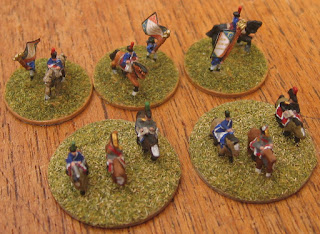Introduction
It's been a while since I posted anything about
Frostgrave. I haven't abandoned the game; it's just that other things have been higher up the priority list for a while. However, here's some stuff...
A little while ago, the "Ulterior Motives" expansion was released for Frostgrave. This is a set of cards that list a hidden agenda for a wizard and his entourage; one card is dealt to each player at the start of a game. Each card is keyed to a location (so, "search the ancient tomb for a relic") and gives bonuses to the wizard who achieves that goal. To make it harder for opponents to guess the task, the cards also list a further set of locations to be placed as decoys; only the player who holds a card will know which is which.
To mark the release of this expansion,
North Star Miniatures produced suitable models for all the Ulterior Motives pieces; these are the items I will describe in the rest of this article.
The Statue
This is a resin model of an old statue. I've done a very simple paint job on it; just an undercoat and wash on the stonework. However, the base has been imprinted from the
Basius II "Dungeon" pad before the statue was stuck to it; this makes it slightly more interesting.
The Tomb
The sarcophagus is another model of a piece of masonry, cast in resin. It has a reclining figure carved onto the lid and runes & other decoration around the base. This time, I built the flagstones on the base from rectangles of thin card. Since it's (likely to be) indoors, I didn't even use any grass, snow or non-stone colours for details; it's probably one of the quickest models I've ever painted!
The Trapdoor
The trapdoor is quite a small piece, so I've placed it on a larger base. Once again, the base was pressed from green stuff using a Basius II pad.
When the green stuff had set a bit but was still somewhat malleable, I cut out a square to fit the trapdoor, taking care to preserve some of the chain which was snaking across the floor. This short length of chain was then draped over the edge of the trapdoor and worked into position; I think it looks fairly seamless! Though it does beg the question of why a trapdoor needs to be opened with a long length of chain, presumably from quite a long way away?
The Standing Stone
The menhir/standing stone is another simple resin block, though this time with carvings on both sides of it. As with the previous items, I based it for stability. The base was then decorated with grit, snow and grass.
The Mystic Circle
This resin piece is a thin circle of flat, carved stones. I've placed it on a much larger base (from some ruined Games Workshop model that my son acquired from a schoolfriend) and added extra, smaller stone disks to make a path leading to the main item.
I tried to paint each of the segments of the mystic circle as if they were glowing in different colours. This didn't really work the way I had hoped; the colours are visible but really don't look as if they are magical lights.
The Crater
The
Ulterior Motives crater is a simple, small crater - pretty much exactly what you might expect. I decided that it was a little bit smaller than I wished, so I mounted it on a large disk of MDF. Filler was then used to blend the resin piece with the base. Painting was very easy: just earth/dirt colours. Some snow was added around the edge to help blend in with the gaming table.
The Portal
This strange, free-standing archway took longer to build and paint than any of the other pieces in the collection. Why?
Well, it took longer to build because the back was just flat resin; I smoothed this off and added extra buttresses and stonework detail (not visible in this picture).
The portal took longer to paint because I decided to try painting the stonework as marble. I also tried to make the runes above the arch glow in a strange, blue colour. I'm reasonably happy with the result, though not completely delighted.
I also spent time wondering whether I should try to model some type of shimmering effect in the doorway itself, to hint at the magical nature of the doorway. Possibly this could be done with translucent plastic painted with a swirling pattern of some colour? In the end I felt that this would need to be done exceptionally well or else it would just look naff, so I decided not to do it.
All Together
Here are all the
Ulterior Motives pieces together. Note that I've extended/enhanced each of these, so they are all quite a lot bigger than the simple resin parts.
Some of you may know that there are
8 Ulterior Motives items altogether. I've only shown 7 here, so what's happened to the last one? Well, the 8th item is a zombie rather than a terrain piece and frankly I don't think it's the best model of a zombie that I've ever seen. I will paint it up and use it; you'll hear about it in a future post - but not yet (I have a special idea for it).
Finally, you may remember that I had acquired several MDF entry tickets when visiting the
Carronade show in 2016 and 2017. At the time, I remarked that I really ought to use these pieces as bases for something, but couldn't quite work out what. Well, they were perfect for this job, so 4 of the Ulterior Motives terrain pieces are mounted on "Carronade" bases!





















